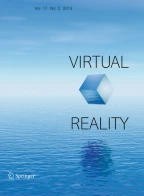Abstract
The aims of this paper are twofold. First, it identifies the general requirements of future large-scale distributed virtual reality (VR) systems based on an analysis of current VR systems, of more general distributed systems platforms and a consideration of the key issues of scale and heterogeneity. These requirements subsequently inform the development of a general VR reference architecture; and a framework which identifies the key software components which will comprise future distributed VR systems. Second, it uses this reference architecture as a vehicle for conducting a broad review of current distributed VR products and research prototypes. The review covers twelve well known VR systems and intended as a general resource for researchers entering the field. These systems are: AVIARY, BrickNet, DIVE, dVS, MASSIVE, the MR Toolkit, NPSNET, Superscape, VEOS, VUE, WAVES and World Toolkit. The review also identifies relevant standards in the areas of computer graphics and distributed systems. The paper finishes by drawing out a number of more general conclusions from the review including the urgent need to conduct research into the subjects of security and resource discovery for distributed VR systems.
Similar content being viewed by others
Explore related subjects
Discover the latest articles, news and stories from top researchers in related subjects.References
Appino, A.P., Lewis, J.B., Koved, L., Ling D.T., Rabhurst, D.A. and Codella, C.F. (1992). An Architecture for Virtual Worlds,Presence 1(1), Winter 1992, pp 1–17, MIT Press.
Bence, B.T. (1993). ANSA—Industry Collaboration in Distributed Systems,BT Technology Journal,11(1), 71–70.
Bernstein, P.A. and Goodman, N. (1981). Concurrency Control in Distributed Database Systems,Computing Surveys,13(2), pp. 185–221.
Bernstein, P., Hadzilacos, V. and Goodman, N. (1987).Concurrency Control and Recovery in Database Systems, Addison-Wesley.
Birman, K., Cooper, R., Joseph, T., Marzillo, K., Makpangou, M., Kane, K., Schmuck, F., and Wood, M. (1990).The ISIS System Manual, Version 2.1.
Bullock, A.N. and Benford, S.D. (1994). An Approach To Access Control for Collaborative Virtual Environments, Proc.6th ERCIM Workshop, Stockholm.
Carlsson, C. and Hagsand, O. (1993). DIVE—A Multi-User Virtual Reality System,VRAIS'93, IEEE Virtual Reality Annual International Symposium, 394–400.
DEC (1991). Digital Equipment Corporation, Hewlett-Packard Company, HyperDesk Corporation, NCR Corporation, Object Design, Inc. and SunSoft Inc. The Common Object Request Broker: Architecture and Specification,OMG Document Number 91.12.1
Deering, S. (1989). Host extensions for IP multicasting,RFC 1112.
DIS (1993). Institute of Electrical and Electronics Engineers, Standard for Information Technology, Protocols for Distributed Interactive Simulation,International Standard ANSI/IEEE Std 1278–1993.
Division Ltd. (1993).dVS Technical Overview, Version 2.0.4.
Fahlén, L.E., Brown, C.G., Stahl, O., and Carlsson, C. (1993). A Space Based Model for User Interaction in Shared Synthetic Environments, in Proc.InterCHI'93, ACM Press.
French, M. (1993). An Overview of PEX,Eurographics UK Chapter, Tutorials on Computer Graphics.
Greenhalgh, C., and Benford, S. (1995a). MASSIVE: A Virtual Reality System for Tele-conferencing,ACM Transactions on Computer Human Interfaces (TOCHI), ACM Press (in press)
Greenhalgh, C., and Benford, S. (1995b). MASSIVE: a Distributed Virtual Reality System Incorporating Spatial Trading,Proc. 15th IEEE International Conference on Distributed Computing Systems, Vancouver, Canada.
Grimsdale, C. (1991) dVS—Distributed Virtual Environment System, In Proc.Computer Graphics '91, London, ISBN 0 86353 282 9.
Hagsand, O. (1996). Interactive Multiuser VEs in the DIVE System.IEEE Multimedia, 3(1), pp. 30–39.
Howard, T.L.J., Hewiit, W.T., Hubbold, R.J., and Wyras, K.M. (1991).A Practical Introduction to PHIGS and PHIGS PLUS, Addison-Wesley.
ISO (1988). ISO and CCITT, Information Processing Systems—Open Systems Interconnection—The Directory, ISO 9594-108, CCITT X.500–X.521.
ISO (1990). ISO, Information Processing Systems—Open Systems Interconnection—Open Distributed Processing (ODP), ISO/TC 97/SC21/WG7.
Kalawsky, R.W. (1993).The Science of Virtual Reality and Virtual Environments, Addison-Wesley.
Kazman, R. (1993). Making WAVES: On The Design of Architectures for Low-end Distributed Virtual Environments, Proc.IEEE Virtual Reality International Symposium (VRAIS'93), Washington, USA.
Macedonia, M.R., Zyda, M.J., Pratt, D.R., Barham, P.T., and Zeswitz, S. (1994). NPSNET: A network software architecture for large scale virtual environments,Presence,3(4) MIT Press.
Mockapetris, P.V. (1987). Domain Names—Concepts and Facilities,RFC 1033.
Neuman, B.C. (1992). Prospero: A Tool for Organizing Internet Resources, Electronic Networking,Research, Applications, and Policy,2(1), pp. 30–37, Meckler Publications, Wesport, CT, USA.
OSF (1992). Open Software Foundation,Introduction to OSF DCE, Cambridge, USA.
Ousterhout, J.K. (1994).Tcl and the Tk Toolkit, Addison-Wesley.
Sense 8. (1992),WorldToolKit Technical Brief, Version 1.01.
Shaw, C., Green, M., Liang, J. and Sun, Y. (1993). Decoupled simulation in virtual reality with the MR toolkit,ACM Transactions on Information Systems,11(3), 287–317.
Singh, G., Serra, L., Png, W. and Ng, H. (1994). Bricknet: A Software Toolkit for Network Based Virtual Worlds,Presence, Volume 3, MIT Press.
Snowdon, D., West, A.J. (1994). AVIARY: Design issues for future large-scale Virtual Environments,Presence,3(4), MIT Press.
Van der Linden, R.J., and Sventek J.S. (1992). The ANSA Trading Service, inIEEE Distributed Processing Technical Committee Newsletter,14(1), (Special Issue on Naming Facilities in Internet Environments and Distributed Systems), pp 28–34.
Vince, J.A. (1995).Virtual Reality Systems, Addison-Wesley.
VRML 1, Bell, G., Parisi, A., and Pesce, M., The Virtual Reality Modelling Language, Version 1.0 Specification,URL: http://vag.vrml.org/vrml10c.html
VRML2, Bell, G., Carey, R., and Marrin, C., The Virtual Reality Modeling Language Specification, Version 2.0, July 1996,URL: http://vag.vrml.org/VRML2.0/DRAFT3/
West, A.J., Howard, T.L.J., Hubbold, R.J., Murta, A.D., Snowdon, D.N., and Butler, D.A. (1993). AVIARY—A Generic Virtual Reality Interface for Real Applications,Virtual Reality Systems, Earnshaw, R.A., Gigante, M.A. and Jones, H. (eds.), Academic Press, chapter 15, 213–236.
Zyda, M.J., Pratt, D.R., Falby, J.S., Lombardo, C. and Kelleher, K.M. (1993). The Software Required for Computer Generation of Virtual Environments,Presence,2(2), pp 130–140.
Author information
Authors and Affiliations
Rights and permissions
About this article
Cite this article
Snowdon, D., Greenhalgh, C., Benford, S. et al. A review of distributed architectures for networked virtual reality. Virtual Reality 2, 155–175 (1996). https://doi.org/10.1007/BF02534449
Issue Date:
DOI: https://doi.org/10.1007/BF02534449
